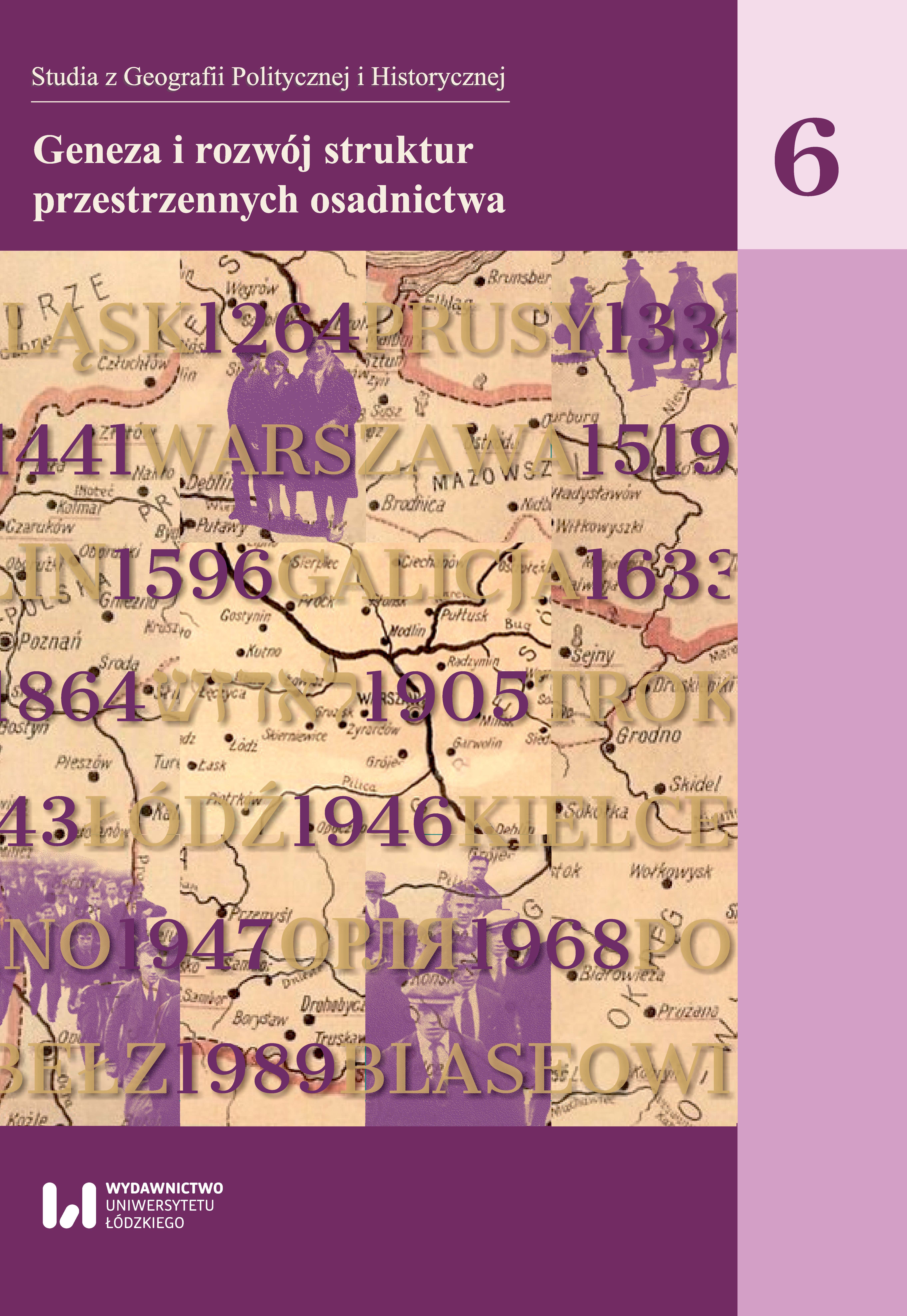Spatial development and morphological transformations of districts arisen around former peasant villages. The case study of the Wrocław city
DOI:
https://doi.org/10.18778/2300-0562.06.03Keywords:
morphological transformations, spatial development of the city, urban morphology, peasant villages, WrocławAbstract
Between the years 1928 and 1973, three towns (Brochów, Leśnica, Psie Pole) and over 50 villages were incorporated into the borders of Wrocław city. It resulted in the growth of the administrative area of the city from 49.2 to 292.8 km2. Amongst the settlements incorporated into the city borders, it is possible to recognize the vegetable, peasant and farm villages. In most cases, former villages became genetic cores, around which current districts of the city were developed. Due to the diversified dynamics and the complex character of morphological transformations, the peasant villages deserve particular attention. An analysis of the spatial development and the main tendencies of morphological transformations of settlements developed around the peasant villages is the main purpose of this article. The majority of peasant villages are located in the western and southern parts of the city. Villages taken into account in the analysis differ in the progress of development processes, morphological diversification of settlements developed around former villages and in the transformations of the habitat of the village (from fully preserved forms to the forms with partly or entirely changed farm buildings). In the case of peasant villages, the morphological transformations have a different scale, from the phase of the minimal transformations (e.g. Jerzmanowo), to the phase where the initial form of the village is becoming blurred and the inter-urban “conglomerate” is developing (Ołtaszyn – Wojszyce).
References
Antkowiak Z., 1973, Stare i nowe osiedla Wrocławia, Wrocław.
Google Scholar
Chmielewska M., 2016, Morfologiczne przekształcenia przestrzeni miejskiej Katowic, Katowice.
Google Scholar
Encyklopedia Wrocławia, 2006, Wrocław.
Google Scholar
Kajdanek K, 2011, Pomiędzy miastem a wsią. Suburbanizacja na przykładzie osiedli podmiejskich Wrocławia, Kraków.
Google Scholar
Kononowicz W., 1997, Wrocław: kierunki rozwoju urbanistycznego w okresie międzywojennym, Wrocław.
Google Scholar
Koter M., 1979, Struktura morfogenetyczna wielkiego miasta na przykładzie Łodzi, „Acta Universitatis Lodziensis”, Nauki Matematyczno-Przyrodnicze, seria 2, z. 21.
Google Scholar
Koter M., 1994, Rola wiejskich elementów morfologicznych w procesie kształtowania układu przestrzennego Łodzi, [w:] M. Koter, J. Tkocz (red.), Zagadnienia geografii historycznej osadnictwa w Polsce, Toruń–Łódź, s. 63–88.
Google Scholar
Maleczyński K., Morelowski M., Ptaszycka A., 1956, Wrocław. Rozwój urbanistyczny, Warszawa.
Google Scholar
Mayer M., Szmytkie R., 2014, Kształtowanie się stref podmiejskich wokół miast średniej wielkości (studia przypadków z regionu południowo-zachodniego), [w:] Jezierska-Thöle A., Biczkowski M. (red.), Zintegrowany rozwój obszarów wiejskich w świetle polityki Unii Europejskiej, t. 2: Wielofunkcyjność obszarów wiejskich, Toruń,s. 121–152.
Google Scholar
Miszewska B., 1994, Bloki urbanistyczne Wrocławia w różnych fazach cyklu miejskiego, [w:] Koter M., Tkocz J. (red.), Zagadnienia geografii historycznej i osadnictwaw Polsce, Toruń–Łódź, s. 111–129.
Google Scholar
Miszewska B., 1995, Wpływ ekspansji przestrzennej Wrocławia na sukcesję użytkowania ziemi i strukturę morfologiczną miasta, „Czasopismo Geograficzne”, 66, s. 363–370.
Google Scholar
Miszewska B., 1996, Struktura morfologiczna peryferyjnych osiedli Wrocławia, „Acta Universitatis Wratislaviensis”, 1904, s. 53–61.
Google Scholar
Miszewska B., 2002, Wsie jako jądra genetyczne osiedli Wrocławskich, „Rocznik Wrocławski”, 8, s. 107–119.
Google Scholar
Miszewska B., Sikorski D., 2011, Blokowiska a dewaloryzacja przestrzeni miejskiej na przykładzie południowej dzielnicy Wrocławia, [w:] Jażdżewska I. (red.), Osiedla blokowe w strukturze przestrzennej miast, seria: XXIII Konwersatorium Wiedzyo Mieście, Łódź, s. 127–139.
Google Scholar
Miszewska B., Szmytkie R., 2015, Morphological processes in the spatial structure of the southern district of Wrocław city, „Bulletin of Geography. Socio-economicSeries”, 27, s. 133–151.
Google Scholar
DOI: https://doi.org/10.1515/bog-2015-0009
Płachta O., Szmytkie R., 2012, Nowa zabudowa mieszkaniowa jako „inna jakość” w przestrzeni wybranych osiedli Wrocławia, [w:] Jakóbczyk-Gryszkiewicz J. (red.), Procesy gentryfikacji w mieście, cz. 1, seria: XXV Konwersatorium Wiedzy o Mieście,Łódź, s. 135–152.
Google Scholar
Szmytkie R., 2011, Osiedla wiejskie w granicach administracyjnych dużego miasta (przykład Wrocławia), [w:] Słodczyk J. (red.), Procesy suburbanizacji w wybranych miastach Polski, seria: Studia Miejskie, 3, Opole, s. 159–186.
Google Scholar
Szulc H., 1963, Osiedla podwrocławskie na początku XIX wieku, Wrocław.
Google Scholar
Downloads
Published
How to Cite
Issue
Section
License

This work is licensed under a Creative Commons Attribution-NonCommercial-NoDerivatives 4.0 International License.








